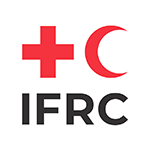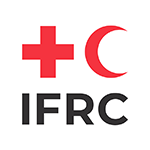Albania
Rains and inadequate infrastructure lead to floods
Albania is a flood-prone country which over the past 15 years has faced increasingly strong, drawn out periods of rain. The country experienced particularly severe flooding in 2010–2011, 2015, and in 2017. Villages located on slopes are also at high risk of landslides.
Inadequacy in and poor maintenance of infrastructure, including deterioration of dyke systems and drainage channels, poorly maintained pumping stations, and illegal construction of buildings in flood prone areas, increase the severity of flood impacts.
From responding to preventing disasters
The Albanian Red Cross (ARC) supported by the International Federation of Red Cross and Red Crescent Societies (IFRC) is implementing the Zurich Flood Resilience Alliance Programme in four communities in the Shkodra Municipality which face particularly high flood risks since 2019. In addition, ARC started working on flood resilience in two more communities in the municipalities of Fieri and Vlora in 2021.
The ARC, supported by the IFRC, is using its expertise and experience in providing humanitarian aid, promoting good health, reducing disaster risk, and advocating for the rights of vulnerable people to build flood resilience in these communities and whole country. This is achieved by developing people’s knowledge and capacity to plan, respond, and recover from flood events and to facilitate risk reduction through behaviour change. The work also contributes to building internal capacity for disaster risk reduction and resilience building within ARC – an organisation largely consistent of volunteers.
Strong relationships are key to success
The Albanian Red Cross has introduced communities and local authorities to a more holistic way of thinking about resilience through the Flood Resilience Measurement for Communities (FRMC). These stakeholders are now able to recognise how different interventions will complement each other and systematically address flood risks in the communities, rather than focus on “silver bullet” solutions.
Beyond the program communities, ARC works with governmental and non-governmental partners to deliver positive impacts to people across the country. For example, a country-wide awareness raising campaign reaching thousands of people is conducted in schools and town centres across Albania every year on 13 October, the International Day for Disaster Risk Reduction. In addition, through advocacy at different levels, ARC promotes key messages of the Alliance and has successfully lobbied for more and better consideration of the community perspective in plans and policies.
Knowledge from Australia
Australia
The Zurich Flood Resilience Alliance is not implementing any community programmes in Australia, but considering the increasing severity and frequency of wildfires in the country, and the successful application of our award winning Post Event Review Capability (PERC) methodology on fires in the USA, the International Institute for Applied Systems Analysis (IIASA) has used the PERC to conduct a holistic review of a wildfire disaster in southwest Tasmania, Australia, in January 2019.
The PERC provides a structured process for learning why a hazard became a disaster and how to avoid future events turning into disasters. The PERC methodology was originally developed to analyse flood events but has proven useful to understand other hazard events too, an example of how our work can have impact beyond flood resilience.
Information about the methodology, and all our PERC reports can be found on the Flood Resilience Portal.
Knowledge From Bangladesh
- The Zurich Flood Resilience Alliance in Bangladesh: country briefing
- Assessing and addressing climate-induced loss and damage in Bangladesh
- Using Community Resilience Vision Statements to Engage Communities in Bangladesh
- Monsoon, floods and COVID-19: building community resilience in Bangladesh
- Update: Impact of COVID-19 and monsoon rains in flood vulnerable communities of Bangladesh
- Community Resilience Action Groups build flood resilience in Bangladesh
- Understanding Natural Capital and Flood Resilience in Bangladesh
Bangladesh
One of the most flood and climate change affected countries in the world
Bangladesh is one of the most flood prone countries in the world. Floods have huge costs for Bangladesh, both in terms of lives, property, livelihoods, and development gains lost. This low lying, coastal country crisscrossed by large rivers is incredibly vulnerable to climate change and associated increases in sea level and rainfall resulting in floods.
Building community resilience in Bangladesh
The Alliance has been working in Bangladesh since 2013 to build community flood resilience.
Both Practical Action and Concern Worldwide work directly with 30 flood prone communities using the Flood Resilience Measurement for Communities (FRMC) to understand and strengthen their capacity to plan, prepare, withstand, and recover from floods. Among other activities we support diverse and sustainable livelihoods options for community members, building their financial capacity to cope with floods.
We use our knowledge from the FRMC, our interventions in communities, and in the case of Concern an in-depth analysis of the role of natural capital in reducing flood risk to work with leaders on local, regional, and national levels to improve flood resilience practice, policy, and investments.
Practical Action Bangladesh is working with communities and key partners in Faridpur district to provide accurate, timely, and accessible flood alerts. By providing Early Warning Voice Messages directly to community members facing imminent flooding, installing Digital Weather Boards in community hubs to warn and inform vulnerable people about floods and risk mitigation, training volunteer Community Resilience Agents to coordinate community responses during floods, and developing a Disaster Alert App that provides warnings, information and enables direct assistance during emergencies, Practical Action Bangladesh have substantively improved the resilience of the communities we work with and for. Read more in our report on localized flood early warning dissemination in Bangladesh.
Concern is currently working with 21 vulnerable communities of Sundarganj Upazila of Gaibandha District and Hatibandha Upazila of Lalmonirhat district, with the aim to build capacity and resilience to protect assets and sistain livelihoods during periods of flooding. Concern has sucessfully mobilized 179 Resilience Self-help Groups (RSHG) through 843 awareness sessions leadership development training, with a total of 357 members from 21 Community Resilience Action Groups, effectively disseminating early warning messages and facilitating early actions at community level. Communities have also been working collaboratively to establish Nature Based Solutions and Natural Capital Based Flood Management practices to prevent soil erosion, embankment failure, ecological restoration and controlling floods. For example, approximately 40,000 trees of different varieties were planted across the 21 communities between September 2021-September 2023.
Knowledge from Bolivia
Bolivia
Beni river basin floods
The communities Practical Action works with are located in the Beni river basin. Every year during the rainy season (November to March) the rivers in the basin overflow. These floods affect plantations, livestock, and fish farming – the main livelihoods of riverine communities. Flood conditions also encourage the spread of diseases and infections.
Working in new communities and expanding existing projects
Practical Action’s work in Bolivia implements the Flood Resilience Measurement for Communities (FRMC) in 11 locations around the municipalities of San Buenaventura, Ixiamas, Rurrenabaque, and Mecapaca. The application of post-flood studies will help better understand the recurrent nature of floods in the region. In addition, Practical Action will apply the FRMC in 4 communities together with the Food and Agriculture Organization of the United Nations (FAO), UNICEF, and Action Against Hunger in Colquencha and Collana, through an on-going, ECHO-funded, project.
Targeting an integrated and collaborative disaster risk reduction approach
To date, the attitude to floods and other hazards in the region has largely been reactive, with a focus on response and recovery rather than preparedness and risk reduction. Knowledge about vulnerability and risk among communities and municipalities is insufficient.
Practical Action works with communities and with municipal risk management units to develop multi-sectorial plans and implement interventions based on the results of the FRMC. We work in partnership with national technical institutions and NGOs associated with the Consortium of Humanitarian Agencies of Bolivia (CAHB) and the Bolivia Humanitarian Team (EHP) and will seek collaboration with other actors working on Disaster Risk Reduction in the area.
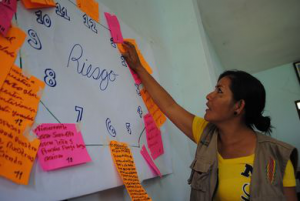
Knowledge from Costa Rica
Costa Rica
Multiple vulnerabilities leading to high flood risk
Prolonged rains create floods in the plains of the country while intense downpours lead to flashfloods as well as land and mudslides in mountainous areas, both causing deaths and damage to agriculture, housing, commerce, and infrastructure. In Costa Rica vulnerability conditions, increases in population and settlements without planning, poor distribution and use of land, and the mountainous geography of steep slopes have created great ecological and social imbalances that can lead to devastating floods.
Evaluating and improving governance for Disaster Risk Reduction
As part of the Zurich Flood Resilience Alliance (the Alliance) and supported by the International Federation of Red Cross and Red Crescent Societies (IFRC), the Costa Rican Red Cross implemented a Disaster Law program from February 2019 to February 2022 with the objective to assess the Costa Rican legal framework for Disaster Risk Reduction (DRR) for floods and to arrive at concrete recommendations for improving the legal framework for DRR.
The program of the Costa Rican Red Cross worked with seven municipalities (Matina, Siquirres, Talamanca, in the province of Limón and Bagaces, Cañas, Carrillo and Santa Cruz in the province of Guanacaste) that were selected due to high occurrence of floods there.
Through a participatory process involving key actors of the National Risk Management System, the Costa Rican Red Cross and the seven municipalities applied several assessment tools to the legal DRR framework such as the IFRC’S Checklist on Law and Disaster Risk Reduction. The final recommendations of the study focus on strengthening the national legal framework and build capacities at the municipal level in coordination with the National Risk Management System. The study insights and recommendations where shared and discussed with key stakeholders, who committed to taking them forward, and promoted to the public in a large-scale social media campaign.
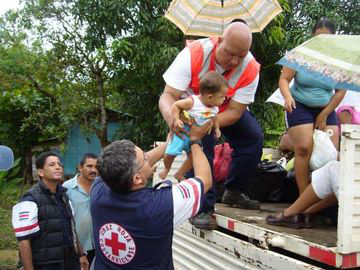
Knowledge from El Salvador
- The Zurich Flood Resilience Alliance in El Salvador: country briefing
- Virtual visit to communities in Nicaragua and El Salvador
- Building resilience through young women: Christina’s story
- Impactos del cambio climático diferenciados por género en niñas, niños y adolescentes de El Salvador
Visit the Latin America Flood Resilience Portal for more knowledge from El Salvador
El Salvador
Most of El Salvador’s population live in hazard prone locations
As much as 89% of El Salvador is at risk of natural hazards. Of these, floods and earthquakes have the worst impacts. Accelerated population growth, absence of river drainage systems, and poor infrastructure conditions are part of the explanation why up to 95% of the population live in hazard prone areas.
In May 2020, as a result of tropical storm “Amanda”, two of the communities where Plan International work as part of the Zurich Flood Resilience Alliance were flooded.
Building capacity for resilience
Plan is working in four communities in El Salvador to increase their resilience to floods. The knowledge gained through this work is captured and shared to build capacity in resilience building programmes within and beyond the Alliance, and to influence national policy and practice.
Plan has established civil-, and school based protection committees, in these four communities. In close collaboration with the General Directorate of Civil Protection (DGPC) Plan is supporting these committees to develop the capacity to coordinate preparedness and response in emergency situations together with the DGPC, reducing their dependency on external aid in the event of floods and other hazards.
Following the Covid-19 pandemic’s impact on communities, Plan facilitates economic recovery by supporting particularly vulnerable households, and family businesses working in the green economy.
How and why Plan focuses on children in floods
Children, especially girls, are often disproportionately impacted by floods and other natural hazards. During and after a flood schools are often used as shelters. Some children, particularly girls, may be forced to give up their education altogether as even when schools re-open they are required to support the family’s recovery.
That is why Plan puts children, especially girls, at the centre of its work in El Salvador, advancing children’s rights through activities like the establishment of school protection committees, and awareness raising campaigns. Plan is working on a study analysing the impacts caused by flooding and climate change on girls in El Salvador. The results of the study will provide additional insights about flood impacts differentiated by age and gender; and how we can and should address the particular needs of children and adolescents when building flood resilience.
Knowledge from Germany
- Building flood resilience in a changing climate: Flood risk management in Germany
- Flash floods: a grim reminder that adaptation is as important as reducing emissions
- Hochwasser Resilienz Messung auf lokaler Ebene (Flood Resilience Measurement for Communities in German)
- Flash Floods: The underestimated natural hazard
Germany
Flooding is Germany’s number one natural hazard
Germany is exposed to coastal, fluvial, surface water, and flash flooding. Riverine flooding is a major concern across the whole country, in addition, localised urban flash floods are a growing concern.
Both climate change and socio-economic factors contribute to rising flood risk levels, including land use and land cover practices such as soil sealing, ageing drainage infrastructure, and insufficient catchment-wide flood prevention planning. Flood risk management efforts in Germany have traditionally focused on riverine floods and storm surges along the coast.
A holistic approach for improving urban flood resilience
The London School of Economics and Zurich Insurance Group work in North Rhine-Westphalia with two urban communities facing river and surface water flood risk to systematically analyse their flood resilience. By implementing the Flood Resilience Measurement for Communities (FRMC) local partners are supported in their efforts to ensure long-term flood resilience. Using the FRMC tool, LSE and Zurich work with local government (and other stakeholders) to collect data, measure flood resilience, and design interventions. The participatory nature of this approach also supports increasing risk awareness as well as acceptability and credibility of selected resilience measures within the communities.
Combining academic research with local expertise
LSE and Zurich work closely with local flood risk managers as well as other academic partners from Germany to integrate their work into existing research collaborations. This way latest research findings, combined with the Alliance’s innovative FRMC approach ensure the best possible knowledge base for local decision makers to improve their communities’ flood resilience.
Merging existing data and research findings on flood risk in the communities with information from households, businesses, and other flood-relevant actors enables the community to systematically analyse the strengths and weaknesses regarding the communities’ flood resilience from different angles, helping local decision makers prioritise flood risk management spending.
Knowledge from Honduras
Honduras
Disasters hampering development and exacerbating poverty
In the last 20 years, Honduras has been one of the most disaster affected countries in the world. Disaster impacts in Honduras negatively affect development and contribute to increasing poverty.
In the last two decades about 15 per cent of the country has suffered from floods. Where the Alliance works in Villanueva, San Pedro Sula, Choloma and Sula Valley, more than 26 per cent of the territory has been affected.
Understanding and improving Disaster Risk Reduction policy and practice
Between 2019 and 2022, the Honduran Red Cross implemented a flood resilience program focusing on disaster law with support from the IFRC and in coordination with municipal, regional, and national authorities as well as private companies and civil society actors.
The goal of the Alliance programme in Honduras was to improve the governance of and the legal framework for Disaster Risk Reduction (DRR). For this purpose, the programme analysed the current regulatory framework for DRR and from this develop recommendations and proposals for improvements using amongst others the IFRC’S Checklist on Law and Disaster Risk Reduction
Achieving change through multi-sectoral collaboration
In the project areas, a multi-sectoral coalition was formed consisting of municipal governments, private companies, the regional risk management authority, and others. This coalition accompanied all programme activities, which will ensure ownership of the analysis and recommendations emerging from the program by relevant actors. Along with the study and the advocacy strategy that was developed based on the study, several DRR workshops and trainings were provided to members of the coalition, local communities, and other partners to raise their awareness for DRR and empower them to engage in DRR advocacy.
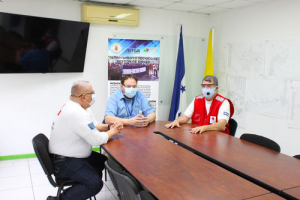
Knowledge from Indonesia
- Integrated urban water resource management for climate resilience: lessons from Indonesia
- Climate Risk And Impact Assessment Pekalongan
- Strengthening resilience of flood vulnerable communities in Indonesia during the COVID-19 crisis
- Inclusive transboundary governance at Asia-Pacific Urban Forum
- Good Governance and Transboundary Collaboration for Climate Change Resilience
Indonesia
Rising sea levels impact thousands of villages
Indonesia has experienced around 300 natural hazard events annually over the past 30 years. 77 per cent of these were hydrological hazards, with flooding the most frequent. Rising sea levels and high tides contribute to coastal flooding which has impacted 3,000 villages between 2016-2018. Rapid land use change and river sedimentation causes frequent flooding in major cities. Floods cause economic losses and have long term effects on people’s quality of life and the environment.
Research based influencing of policy and practice
Through the Zurich Flood Resilience Alliance programme, Mercy Corps Indonesia seeks to address the root causes of flooding and its impacts through evidence-based policy and programme support. Mercy Corps Indonesia works closely with Pekalongan City and Regency, on the North coast of Java, to improve flood management policies in an area affected by coastal, flash and urban flooding.
They’re also conducting a Climate Risk and Impact Assessment on the Kupang River Basin together with three leading research institutions. The basin plays a strategic role in the regional water supply system, but also poses significant risks of coastal and urban flooding. The assessment has provided evidence on the connection between upstream and downstream activities, especially on flooding impacts; while also analysing losses resulting from floods.
Research findings change the perspective of policy makers
85 per cent of the Pekalongan City area is predicted to be permanently inundated by 2035.
Initial findings from the Climate Risk and Impact Assessment showed that the primary cause of flooding and inundation in the area is the high land subsidence rate which is primarily caused by massive groundwater extraction.
This evidence has made the Pekalongan City, Regency, and Central Java Province government understand that conventional flood protection measures will not be sufficient to mitigate flood risk without considering broader land use and future climate variability.
The ongoing research will provide the local government with data which will help them address flood risk not only from a disaster management perspective, but also using a holistic water resource management lens. This also informed the promotion of resilient livelihoods, a people-centred resilience measure complimenting the traditional structural-based intervention in the region.
The findings from the Pekalongan research, which convey the importance of adopting a landscape perspective and a trans-boundary governance approach in climate adaptation and water resource management, are also feeding into the development of national policy frameworks. Mercy Corps Indonesia has supported the Government of Indonesia to develop policies and positions for the UNFCCC process such as COP and its intercessional process, Nationally Determined Contributions (NDCs), and the National Action Plan for Climate Change Adaptation.
In the future Mercy Corps Indonesia will be supporting the national government in strengthening the governance concerning climate-induced loss and damage.
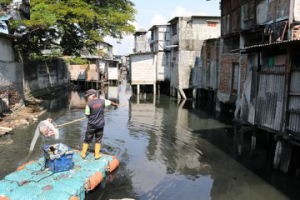
Jordan
Increasing climate stress on Jordan’s population
Jordan is increasingly seeing effects of climate change in the form of changing weather patterns and devastating flash floods. Two “100-year return period” floods took place in late 2018. Parts of the kingdom were ravaged with devastating outcomes. These floods killed dozens of school children in a canyon near the Dead Sea and tourists in Petra, the country’s most important tourist attraction, where also key infrastructure was damaged. This event made the case for strengthened flood risk management, communication, and early warning systems. Floods are, in addition to causing fatalities, also resulting in loss of infrastructure and income to households, farmers, and businesses, exacerbating extreme poverty and deprivation.Focusing on flash flood impacted communities
Mercy Corps Jordan is working in 10 communities that face challenges due to frequently occurring flash floods. These communities are located in urban, heavily populated areas where action to manage flood risks is currently inadequate, and where social tensions create a challenging environment. Mercy Corps has a strong relationship with the UK Department for International Development (DfID), now the Foreign, Commonwealth and Development Office (FCDO), which has supported initial analysis using the Flood Resilience Measurement for Communities (FRMC). FRMC results will support action and help implement interventions that enhance community flood resilience. The learning from applying the FRMC will also help to advance discussions with humanitarian organizations like the United Nations Office for the Coordination of Humanitarian Affairs (UN OCHA) to ensure flood resilience is considered in relevant humanitarian operations, and in national and regional climate change conversations in the Middle East. Mercy Corps’ work will also include collaborations with UN HABITAT and will continue to highlight the benefits of the FRMC with the FCDO.Knowledge from Kenya
Kenya
Working in rural areas with pastoral communities
Concern Worldwide Kenya is working in the coastal area of Tana River with 13 communities predominantly made up of rural farmers. In addition to being one of the poorest counties in Kenya, the area is also badly affected, often twice a year, by fluvial flooding. The floods are caused by excessive rains during the short rainy season (October to December) and the long rainy season (March to May). These effects are exacerbated by the release of excessive water from a dam system.
The issues facing people in the Tana River area are examples of increasing climate change related pressure, which also makes flooding increasingly unpredictable.
As of 2023, agriculture accounts for 67 percent of employment in Kenya, with flooding taking a severely destructive effect on people’s lives and livelihoods. During the floods of 2018, 70% of the county was submerged under water, with two thirds impassable by road. We expect a similar statistic to the 2023 but currently awaiting new data which is expected in the first quarter of 2024.
Implementing locally sources solutions to improve flood resilience
Concern is working within existing flood resilience structures and partnerships in Kenya as part of the ZFRA programme. At the community level, Concern partners with communities to develop ways to prevent or mitigate flood impacts and adapt to and prepare for floods in a changing climate using local knowledge systems, materials, and methods.
Concern is also working through various community level structures that can be leveraged to reinforce pre-event community resilience, for example early warning systems, collaborating with existing partners in the area, including the county government, Kenya Redcross Society, WFP, CISP, WHH and Nature Kenya.
Between 2021 and 2023, the Alliance supported 3 communities in setting up minor irrigation schemes, opening 150 acres of land further away from the riverine thus reducing perennial crop losses due to flooding. To diversify livelihoods and ensure that communities build longer-term resilience without dependence on just one type of livelihood, trainings and equipment for modern bee keeping practices were provided. 39 Advocacy Champions have also been trained, attending public participation forums for the County Integrated Development Plan (CIDP), a 5-year plan prepared by every County Government. As a result, 77% of the Alliance supported communities had at least one priority incorporated in the CIDP including minor irrigation schemes, footbridges and drilling of boreholes. Annually, the communities, through their community champions will attend the budget development participation meetings to ensure their community priorities are included in the annual development plans and consequently the annual county budgets. In addition, the plans will be reviewed annually based on changing context and presented to other stakeholders within the county.
Furthermore, to improve water, hygiene and sanitation during floods Concern carried out Community-Led Total Sanitation (CLTS) in 5 communities which included sensitization, behavioural change and the construction of toilets, handwashing stations and disposal pits.
At the national level, Concern is engaging with key stakeholders during the development of the Kenya National Policy for Disaster Management. We are also building on existing relationships with stakeholders in Disaster Risk Reduction including the Kenya Red Cross, the National Drought Management Authority, and with agencies tasked with flood mitigation such as the National Water Conservation and Pipeline Corporation (NWCPC), the main agency in implementation of flood mitigation projects in Kenya.
Knowledge from Malawi
Malawi
Flooding as a main driver of challenges to achieving poverty reduction
Malawi has made progress towards the Sustainable Development Goals but still faces significant challenges to achieving poverty reduction. Flooding in Malawi is primarily because of seasonal cyclone events, which are becoming more frequent and great magnitude due to climate change. Since more than 90 percent of the food production in Malawi relies on a single rain-fed crop-season, the country is highly vulnerable to meteorological hazards and disproportionately affected by climate change driving unpredictable rainfall patterns.
Understanding the effects of Cyclone Idai
When Cyclone Freddy hit Malawi in March 2023 the country experienced its worst floods in 50 years, which destroyed 179,000 hectares of crop fields, with a death toll of 679, over 500 people still missing and displacing over 650,000 people into temporary camps. The impacts of Cyclone Freddy were greater than those experienced due to Cyclone Idai in 2019, with more districts affected. However, the availability of resources and international funding was less.
The Post Event Review Capability (PERC) provides a structured process for learning why a hazard became a disaster and how to avoid future disasters. The large-scale impact of the event on areas and populations that are very familiar with floods provided a useful opportunity for resilience learning, thus motivating a PERC study carried out by ISET-International, Zurich Insurance Group and Practical Action. The findings and recommendations from this study can be found to your left or on the page hosting all Post Event Review Capability reports. In addition, the Concern team conducted a Post Event Survey (PES) which utilised a streamlined version of the FRMC tool.
Working with communities in the southern district of Nsanje
Malawi’s southern district of Nsanje is located in the Lower Shire livelihoods zone, one of the poorest areas of the country and a priority district for flood prevention in the National Resilience Strategy. Since 2019, Concern has been implementing a project utilising the Flood Resilience Measurement for Communities (FRMC) tool to target 15 most flood-prone communities in 7 traditional authority areas across Nsanje. The project works at community and district level to identify and support community action on local resilience building action plans that have been developed based on analysis of the FRMC findings on 44 sources of resilience, and 5 capitals (human, financial, physical, natural and social). Key findings included that there is a lack of financial capital at all levels, and lack of investment preparedness, risk reduction and recovery stages of the DRM cycle.
In addition, Concern is a member of the National Disasters and Relief technical committee, and the National Technical Committee on Early Warning Systems, as well as contributing to the national and district level cluster meetings following flood incidence in the country. These government-led committees discuss and approve approaches to disaster resilience and Disaster Risk Reduction planning and action. Through these mechanisms, Concern shares examples of good practice from the Zurich Flood Resilience Alliance. Concern also contributed to our experience in flood response to district and national level after action reviews following Cyclone Freddy, and contributing to CISONECC review of the new DRM Act when it was tabled in Parliament.
Knowledge from Mexico
- The Zurich Flood Resilience Alliance in Mexico: country briefing
- Community brigades were put to the test during floods in Tabasco, Mexico
- Using the Flood Resilience Measurement for Communities in Tabasco
- Flood Resilience Alliance 2013-2017: A final review in Indonesia, Mexico and Nepal.
- Community testimonials: Flood resilience in Nepal, Indonesia and Mexico
Visit the Latin America Flood Resilience Portal for more knowledge from Mexico
Mexico
Extreme weather challenges
Mexico is susceptible to different types of natural hazards, such as droughts in the desert zone of the north, frosts in the northwest and northeast, heavy rains in the south and tropical cyclones along the coast. Particularly, floods have significant negative impacts due to high immediate losses and gradually increasing vulnerability of communities. Floods cause more than half of all material damages and loss of life from all disasters. For 2020, the National Center for the Prevention of Disasters estimated that 83 percent of the socioeconomic impacts from disasters were attributable to hydrometeorological phenomena.
Leveraging successes in Tabasco to build flood resilience in San Luis Potosi
The Mexican Red Cross has been a member of the Zurich Flood Resilience Alliance and implemented community flood resilience programs in rural communities in Tabasco since 2013. In 2021 the Mexican Red Cross expanded its community flood resilience work to urban communities in a new state, San Luis Potosi.
The Mexican Red Cross aims to increase community flood resilience by building local capacity, enhancing the effectiveness of existing, and developing new, innovative, and scalable flood risk management approaches. The Flood Resilience Measurement for Communities (FRMC), along with other methodologies, is applied to understand and strengthen community resilience. To navigate the complexity of the urban context in San Luis Potosi, the Mexican Red Cross uses its experience from building community resilience in Tabasco and adapts it to the new context. In doing so, the program works closely with and through institutions in the health, education, and civil protection sector.
The knowledge and experience gained from measuring resilience, project implementation and specific post-event reviews of disasters is shared with communities, practitioners, and policy makers and used as evidence to advocate for better laws, policies, and plans. For example, the community brigade methodology of the flood resilience program of the Mexican Red Cross has been rewarded with the National Civil Protection Award and integrated into the latest state development plan of Tabasco.
Zurich Mexico’s role in resilience building
Zurich Mexico works together with the Mexican Red Cross to promote flood resilience. Among other actions taken Zurich Mexico has signed a collaboration with the Secretary of Integral Risk Management and Civil Protection, is a member of the ARISE network in Mexico, a United Nations led community of private sector actors focused on resilience, and is part of the Mexican Alliance of Biodiversity and Business where it leads on flood risk management and co-ordinate the risk committee.
Montenegro
High flood risk in the Lake Skadar region
In Montenegro, heavy rainfall, rain lasting for several days in a row, and melting of snow in mountainous regions can lead to a sudden rise of water levels in rivers and lakes. Especially around Lake Skadar, numerous settlements, industrial facilities, and agricultural land are regularly affected by floods. Dramatic examples are the floods in 2010 and 2011, when half-century records of water levels in rivers and Lake Skadar were reached.
Assessing and building community flood resilience
As a humanitarian auxiliary to the government, the Red Cross of Montenegro is an integral part of the country’s disaster management system and participates actively in disaster preparedness and response, disaster risk reduction, and climate change adaptation activities.
As part of the Zurich Flood Resilience Alliance, the Red Cross of Montenegro works with communities in the Lake Skadar basin to build flood resilience in close cooperation with the municipality of Golubovci, who contributes both financial and technical resources to the program. This partnership enables the implementation of physical capital interventions such as a flood protection wall and flood canal that complement the Red Cross’ work in the areas of mostly human and social capital.
Local activities influencing national plans
The program communities have adopted local flood protection plans, which contain measures for increasing community flood resilience. Programme activities that align with these are contributing to the implementation of the National Disaster Risk Strategy, its plan of action, and the National Plan for Flood Protection. Thereby, the Red Cross of Montenegro maintains and builds its reputation as a key resilience actor getting access to important institutions and committees, where it shares the results and insights from its flood resilience work to influence relevant policies and investments.

Knowledge from Mozambique
- When the unprecedented becomes precedented: Learning from Cyclones Idai and Kenneth
- Learning from Cyclones Idai and Kenneth: Executive Summary
- Learning from Cyclone Idai and Cyclone Kenneth to Inform Long-term Disaster Risk Reduction Programming in Mozambique
- Bridging the divide
- Reflections on disaster events on the one-year anniversary of Cyclone Idai
Mozambique
Recent events highlight the need to build flood resilience in Mozambique
The impacts of Cyclone Idai and Kenneth in 2019 – both severe storms the likes of which are predicted to become more extreme and frequent with climate change – demonstrated that Mozambique is not sufficiently adapted to the high flood risks it faces. Cyclone Idai was the deadliest storm ever to hit Africa and the largest humanitarian disaster of 2019, causing 1,300 deaths across south-eastern Africa. Cyclone Kenneth, which made landfall a month later with wind gusts of 220 km/h was the strongest cyclone to ever make landfall in Africa.
The Mozambique Red Cross (CVM) is working in six highly flood-prone peri-urban (Beira) and rural communities (Buzi) that were hit hard in 2019. Floods, cyclones, erosion, and sea-level rise are recurrent and serious issues facing these communities which are further exacerbated by challenges of high poverty and interrelated socio-economic stressors.
Findings from post-event on Cyclones Idai and Kenneth support implementation
The programme takes forward the key recommendations of the Post-Event Review Capability (PERC) as well as the insights gained from the Flood Resilience Measurement for Communities. At the community level, CVM works with local authorities and the National Disaster Management Agency to establish or revitalize community disaster management committees, raise awareness of the population for risks and protective actions and restore flood mitigation infrastructure.
In addition to these own community-level activities, CVM and the IFRC advocate for better laws, policies and plans for resilience building and climate change adaptation. Key priorities of these advocacy activities are to improve early warning capacities, which is amongst others informed by CVM’s forecast-based financing project, and to push for nature-based solutions to flood risks.
Knowledge from Nepal
- The Zurich Flood Resilience Alliance in Nepal: country briefing
- Avoiding a perfect storm: COVID-19 and floods in Nepal
- Missing Voices: Experiences of floods and early warning from marginalized women in Nepal and Peru
- Flood preparedness during Covid-19
- Gender and Early Warning Systems: Lessons from Nepal and Peru
- Budget governance for disaster risk reduction and climate change adaptation under Nepal’s new federal system
- Assessing and addressing-climate induced loss and damage in Nepal
- Pre-monsoon preparedness – Coordinated actions during flood
Visit the Nepal Flood Resilience Portal for more knowledge from Nepal, much of which is in Nepali.
Nepal
Hazard prone topography
Nepal, with its diverse geography, is susceptible to a wide range of hazards. Every year lives and livelihoods are lost, and vast physical and economic damage is done as monsoon rains result in floods and landslides.
Current investment in, and governance of, flood resilience at the local level, where people are most affected is inadequate.
Building resilience locally and at scale
The Alliance has been working in Nepal since 2013. Today there are three partners working in Nepal, Practical Action, Mercy Corps, and the Nepal Red Cross Society supported by the IFRC. These partners leverage their specific strengths to achieve joint objectives of increased flood resilience in communities, increased investment in flood resilience by local government, and improved policies at all levels of governance.
By collecting learnings from Alliance partners, and aligning with the Managing Risks through Economic Development (M-RED) program, which works on disaster risk reduction through market systems, Mercy Corps Nepal conducts research and training to support systemic changes in governance systems. The team is integrating the Flood Resilience Measurement for Communities (FRMC) into existing work to ensure interventions enhance resilience building. In 2021 Mercy Corps is expanding work in Nepal in 14 communities, as part of the MRED project. The communities are located to the west of the Karnali, neighbouring Practical Action’s work area, in low-lying areas subject to riverine and flash flooding driven by extreme rainfall.
Practical Action works directly with communities to build their capacity to prepare for and respond to floods. They use the learning from this work to influence policy and practice that works for those most vulnerable to floods. In 2021 Practical Action expanded the existing programme in the Karnali river system to 15 additional communities located in the lower Karnali basin, they now work with 25 communities in the country. Working in partnership with the Insurelsilience Solutions Fund, Practical Action developed an innovative, index-based parametric flood insurance product to cover losses and damage incurred by rice paddy-farmers due to floods in the Terai region of Nepal. Following a successful pilot scheme in 2022, the product was launched on a wider scale in 2023.
Nepal Red Cross Society advocates for the nationwide scale-up of community resilience-building efforts, engage in policy change, and support the dissemination of best practices in community programming, emphasising the role of local actors in sustaining local development strategies that leave no one behind.
While working in Nepal the Alliance has carried out two Post Event Review Capabilities analysing and learning from disastrous floods in 2014 and 2017.
Achieving flood resilient policy and practice
All three partners work closely with local and national governments in Nepal influencing their policy and practice.
The Alliance has worked with a range of partners to develop a tool which will allow municipalities to self asses their disaster risk and take action for resilience building, they have provided expert advice to the National Adaptation Plan in Nepal, and influenced municipality and province level spending on disaster risk reduction and climate change adaptation.
New Zealand
Frequent, damaging, and costly floods
Floods are New Zealand’s most frequent, damaging and disruptive natural hazard – including the flooding in Southland that cost $19.68 million; cyclone Debbie in 2017 that cost $91.4 million; and nationwide floods in 2019 that cost almost $16 million in insurance claims.
As our climate changes, flooding caused by both increased rainfall and rising sea levels – in coastal areas and on floodplains – is expected to increase. As floods become more common and severe, the social, cultural, economic, and environmental impacts of flooding will increase.
Culturally informed community engagement for flood resilience
The flood resilience program of the New Zealand Red Cross was implemented in Edgecumbe and Tairawhiti from 2019 to 2022 with the aim of increasing collaboration to jointly build flood resilience, particularly focusing on the inclusion of Maori communities. Together with local authorities and partners community emergency awareness, evacuation and response plans and guides were developed that consider the local cultural and socioeconomic context. Together with local partners, the New Zealand Red Cross also successfully advocated for increased investments in flood preparedness in the area by the central government. In addition, the New Zealand Red Cross’ ‘Good & Ready’ program that is implemented across the whole country has been updated to include latest scientific insights on behaviour changes to promote disaster preparedness.
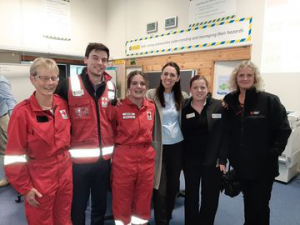
Nicaragua
One of the world’s most hazard prone countries
Nicaragua ranks fourth globally in terms of countries most vulnerable to flooding and other natural hazards. Floods cause severe impacts on people’s livelihoods in rural and urban communities and damage to goods and services, resulting in a decline in Nicaragua’s national economy. Plan International works in communities which over the past ten years have been seriously affected by flooding. The communities are located between 0 and 35 meters above sea level, whilst being surrounded by mountainous areas from which flood waters flow and cause destruction. The most recent flood in the area where Plan International work occurred in October 2018.
Flood resilience programme enabling strong Covid-19 response
Plan is working in four communities in Nicaragua to increase community resilience to flooding by using the Flood Resilience Measurement for Communities (FRMC) and tracking changes over time. The knowledge gained through this work is captured and shared to build capacity in resilience building programmes within and beyond the Zurich Flood Resilience Alliance, and to influence national policy and practice.
Community members Plan works with have identified the lack of organised groups as a key issue, in response Plan is establishing community, and school based, groups to coordinate preparedness and response to floods, and provide these groups with basic equipment. The outbreak of Covid-19 has demonstrated the effectiveness of these groups, which have facilitated widespread participation and well-coordinated response to the pandemic.
Access to safe water was identified as another key issue which is why Plan Nicaragua together with the Nicaraguan Institute of Territorial Studies (INETER) is conducting a study on access to water, how this is impaired during emergency situations, and possible solutions.
How and why Plan focuses on children in floods
Children, especially girls, are often disproportionately impacted by floods and other natural hazards. During and after a flood, schools are often used as shelters. Some children, particularly girls, may be forced to give up their education altogether as even when schools re-open they are required to support the family’s recovery.
This is why Plan puts children, especially girls, at the centre of its work in Nicaragua, advancing children’s rights by for example strengthening capacities of school groups, supplying them with emergency kits and other equipment, jointly developing flood response plans, and installing safety and evacuation signs around the schools.
Knowledge from Peru
- Community Resilience, the Power of People: a video from Practical Action’s work in Peru in Phase 1
- Gender Transformative Early Warning Systems: Peru
- Peru 2017: Risks, Disasters, and Reconstruction
- Learning from El Niño Costero 2017: Opportunities for Building Resilience in Peru
- Rainfall and Citizen Science: an infographic
- Women building resilience: a blog about the San Miguel de Viso plant nursery
- Building flood resilience: one woman’s passion for helping her community
- How can participatory monitoring help us better understand rainfall?
Visit the Latin America Flood Resilience Portal for more knowledge from Peru
Peru
El Niño causing severe floods in Peru
Rainfall in Peru is heavily influenced by the periodic ‘El Niño’ phenomenon which places people in the coastal zone at risk of regular flooding. In 2021 Practical Action is expanded its work in the country across three watersheds, the Rimac, Chillón (department of Cusco), and Vilcanota-Urubamba (department of Peru’s capital Lima) rivers, working with 16 communities. All face rapid-onset floods and are subject to intense rainfall and associated hazards.
In 2017, unusually warm water off the Peruvian coast caused extreme rainfall which in turn generated flooding and landslides which lasted for nearly three months, affecting 1.5 million people, causing 162 deaths, and damaging hundreds of thousands of homes. Learn more about this event in our Post Event Review Capability report.
Reducing vulnerability to natural hazards
Practical Action works to build the resilience of people to the negative effects of climate change such as flooding – reducing people’s vulnerability and exposure to the impact of weather related hazards. Practical Action believes that building community resilience is critical and to achieve this prioritises work in:
- disaster risk reduction governance to improve investment,
- early warning systems to enable early preventative action,
- strengthening ecosystems services for, and disaster risk reduction to, improve river basin health, help protect assets, and strengthen livelihoods of the poorest people living close to rivers.
In collaboration with local communities, Practical Action has built strong relationships with local authorities and technical organisations such as the National Meteorology and Hydrology Service (SENAMHI) and the National Civil Defense Institute (INDECI). Policy and practice has been improved and funding for flood resilience increased, for example through Practical Action’s technical assistance to SENAMHI in their commitment to invest CHF 13.2 million in Early Warning Systems.
Building resilience to floods and pandemics in the rural Andes
Application of the Flood Resilience Measurement for Communities (FRMC) approach which brings together communities and other stakeholders to analyse and strengthen resilience is central to Practical Action’s work.
An example of an intervention generated by applying the FRMC is the establishment of a community tree nursery with the community of San Miguel de Viso. The nursery is part of the Field School for Climate Resilience – a space for theoretical and practical work that aims to strengthen knowledge and promote best practices in climate resilience. Managed by a women’s community group, the nursery provides fresh, nutritious food that contributes to community health when market access is cut due to floods, landslides, or other unforeseeable impacts from events such as the Covid-19 pandemic and lockdown.
Philippines
High exposure to natural hazards but low investment in disaster risk reduction
The Philippines is one of the most disaster-prone countries in the world, commonly experiencing floods, droughts, and typhoons. According to the latest assessment of the World Risk Index (2022), the Philippines is the country with the highest disaster risk in the world. Extreme weather events have been increasing in severity and frequency in recent decades and this trend is projected to continue under climate change.
Metro Manila – where both partners are working – is exposed to sea level rise and is at risk of sinking below sea-level. High population density and limited space to evacuate exacerbate the already vulnerable condition of its marginalised citizens, which amount to a total of 15 million people.
The Alliance has been working in the Philippines since 2019. Today there are two partners implementing in the Philippines: the Philippine Red Cross (PRC) supported by the International Federation of the Red Cross and Red Crescent Societies (IFRC) and Plan International (Plan). These partners leverage their specific strengths to achieve improved flood resilience in communities as well as increased investment and improved policies for flood resilience at all levels of governance.
Alleviating suffering and building resilience
Since 2019, PRC and IFRC have been working with communities in the province of Pangasinan to build their resilience. To date (2023), a diverse set of community resilience building interventions that were developed by the communities have been implemented in partnership with the local government. These interventions include community response groups, a reforestation campaign and disaster risk management capacity building. In 2021, building on the experiences in Pangasinan, PRC has extended its flood resilience work to reach 28 additional communities in highly flood-prone areas in Pasig and Pateros in Metro Manila.
The flood resilience programme is integrated in PRC’s larger framework for community and school-based disaster risk reduction and management, which pursues a community and systems-based approach and includes cross-cutting issues such as climate change adaptation, community engagement, and urban resilience. The programme is implemented in close partnership with local governments, research institutions and other humanitarian and development organisations.
Plan International works with community leaders and different interest groups from seven flood-prone barangays (the smallest administrative unit in the country) as well as decision-makers from the cities of Manila and Navotas. Thereby, Plan builds on the traction of different projects successfully implemented in the past, such as the “Moving Urban Poor Communities towards Resilience” and the “Urban Nexus” projects.
In addition, Plan collaborates with the International Institute for Applied Systems Analysis (IIASA) with the aim to strengthen the Alliance’s approach to the gender-aware application of the Flood Resilience Measurement for Communities (FRMC) piloting a nuanced approach in the Philippines.
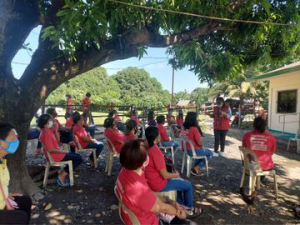
Partners working in Senegal
Senegal
Working in the urban areas of Thies facing flood challenges
Floods in West Africa, partly due to extreme weather events, have increased from fewer than two per year on average prior to the 1990s to over eight per year during the 2000s. Increase in intense rainfalls, rampant urbanisation, and shortcomings in flood risk management, combined with underlying socio-economic, environmental, and climate vulnerabilities creates significant flood risk to West African communities.
The Practical Action team in Senegal is working with eight communities in Thies, a rapidly expanding city neighbouring Dakar, which are particularly exposed to flood hazards as they receive substantial surface flows from the High Plateau located to the east of Thies, the origin of many floods of the Fandane catchment.
Collaborating with long term, locally embedded partners
Practical Action collaborates with institutions such as the Ecole Polytechnique in Thies, a specialised engineering training and research institution, where Masters students are immersed in the flood resilience programme and Jokalante, a local digital solutions agency specialising in conveying messages in local languages and dialects.
The team also works closely with implementing partner IED Afrique. At community level, IED Afrique staff serve as technical advisors to the project team, bringing their experience in research, development planning, participatory monitoring, evaluation and learning, and knowledge publication and dissemination.
Providing flood resilience knowledge to practitioners across West Africa
Despite the high flood risk, and the wide range of stakeholders working on flood prevention, management, and resilience in West Africa, knowledge is not adequately shared. Academic research isn’t disseminated to practitioners, and best practice case studies are not widely shared with colleagues working in communities that could benefit from similar solutions.
To overcome this challenge Practical Action and IED Afrique have developed the West Africa Flood Resilience Portal, combining the two organisation’s expertise to provide Francophone flood resilience practitioners in West Africa with knowledge and resources that will help build community flood resilience in a West African context.
Knowledge from South Sudan
South Sudan
Despite massive flood challenges, resilience remains underprioritised
Despite an urgent need to enhance resilience to flooding, funding remains low in South Sudan.
Floods destroy lives and livelihoods in Northern Bahr el Ghazal
Concern Worldwide has been using the Flood Resilience Measurement for Communities (FRMC) in 12 communities in Northern Bahr el Ghazal (NBeG) state, Aweil North, and Aweil West counties. Flooding in NBeG state is an annual occurrence and affects villages situated in lowlands and flood plains, which are conducive for agricultural activities. As excessive rains occur, flooding is sometimes exacerbated by the overflow of the Lol River causing deleterious impact on community members’ lives, livelihoods, and assets. The communities Concern have been working with are in low-lying agricultural areas clustered along the Lol River, significantly affected by a combination of riverine and pluvial flooding which destroys crops, homes, and contaminates water sources.
When floods occur early in the growth cycle of sorghum crops, South Sudan’s staple harvest, they have a significantly negative effect. The excessive water floods the fields, saturates the soil, and deprives the sorghum plants of vital oxygen for their roots. This waterlogging causes the sorghum plants to drown, resulting in stunted growth, reduced yields, and potentially a complete crop loss. Flooding in South Sudan also has consequences beyond agriculture, preventing access to essential services (education, healthcare and markets) due to impassable roads. This disruption in basic services worsens the challenges faced by communities already impacted by the flood’s effects on their agricultural livelihoods.
Actions informed by system and evidence-based resilience measurement
The application of FRMC in 12 communities, helped to develop resilience actions for the context such as applying the initial analysis to interventions, for example raising the entire homestead compounds and floors of grass-thatched houses, digging water channels, constructing household dykes around farmland, creating communal dykes, and engaging in dry season vegetable production to address food shortages caused by crop failures resulting from floods.
Although annual flooding is one of the major causes of recurrent disaster events in different parts of the country, system and evidence-based resilience measurements have been very limited in this complex humanitarian context. Well positioned in NBeG State, the FRMC has been working to address this gap with many lessons learnt to enhance flood resilience. These include establishing Village Savings and Loan Associations (VSLAs) to serve as a viable platform for raising awareness and contributing to the establishment of community disaster funds; indigenous knowledge and resources play a crucial role in effectively addressing flood risk mitigation and early warning systems; communities situated in flood plains without nearby highlands face isolation during floods and bear the burden of climate-induced shocks alone and as a result, they are highly motivated and willing to develop self-reliance and resilience strategies.
Knowledge from the United Kingdom
- Building flood resilience in a changing climate: Flood risk management in England
- Flood risk is rising and so must our resilience to it
- After the storm: how the UK’s flood defences performed during the surge following Xaver
- Flooding after Storm Desmond
- How can the UK build flood resilience in a changing climate?
United Kingdom
Flood risk in the UK: A major physical climate risk
As an island nation with exposed coastlines, rivers and mountains, floods have played an important role in the history of the UK. The four primary types of flooding include fluvial (riverine), coastal, pluvial (surface water), and groundwater flooding.
Fluvial flooding is the leading cause of flood damage, accounting for approximately half of all annual flood losses. Climate change, population growth, and socio-economic developments are the key factors contributing to the escalating flood risk levels in the UK.
A Comprehensive approach to enhancing urban flood resilience
The London School of Economics and Zurich Insurance Group collaborate closely with East Suffolk Council and Coastal Partnership East in the UK to support long-term flood resilience efforts in the urban areas along the east coast of England.
Through the utilization of the Flood Resilience Measurement for Communities tool, the Alliance assists the local authority in assessing their flood resilience, including identifying gaps and challenges, and designing interventions. This work encourages local stakeholders to consider a wide range of measures that enhance social, human, natural, physical and financial capacities within communities, enabling effective mitigation of current and future flood risk.
Supporting resilience decision-making
The outcomes of this collaboration have been instrumental in developing grant proposals by the local authority. As a result, the East Suffolk Council successfully secured £8 million of the national funding for various flood resilience projects in Norfolk and Suffolk. Furthermore, the outcome of this project has been served as valuable local evidence for consultation on the UK’s National Flood and Coastal Erosion Risk Management Strategy for England
Knowledge from USA
- What can be learned from the Columbia and Charleston floods 2015?
- Floods in Boulder: a study of resilience
- Houston and Hurricane Harvey: a call to action
- The role of businesses in community recovery
- Why small businesses should invest on preparedness
- Hurricane Florence: Building resilience for the new normal
- California fires: Building resilience from the ashes
United States of America
In Phase I of the Alliance, the Flood Resilience Measurement Tool was implemented by the National Academy of Sciences as part of the Resilient America Roundtable in Charleston, South Carolina and Cedar Rapids, Iowa. In Charleston, this contributed to the launch of the Charleston Resilience Network, which has continued to gain momentum and influence. In Cedar Rapids, it furthered work begun after historic flooding in 2008.
In parallel, Zurich Insurance Group and ISET have conducted a series of post-disaster event reviews using our award winning Post Event Review Capability (PERC) methodology to review and learn from a range of disasters across the country. The PERC provides a structured process for learning why a hazard became a disaster and how to avoid future disasters. Below is a short summary of the events in the USA on which we have conducted a PERC. Information about the methodology, and all our PERC reports can be found on the Flood Resilience Portal.
South Carolina Floods: What can be learned from the Columbia and Charleston floods 2015?
In October 2015 Tropical Storm Joaquin unleashed historic rainfall across North and South Carolina, resulting in flooding and flash flooding, dam failures, and bridge and road closures. In South Carolina, the rainfall intensity and volume, coupled with the very different ways the event played out in Charleston and Columbia, motivated ISET and Zurich, with support from Aon Benefield, to carry out the PERC.
Boulder Floods: Floods in Boulder: a study of resilience
In September 2013 Boulder, Colorado, received over 17 inches of rain – nearly a year’s worth of precipitation – in one week. The historic nature of the rainfall and flooding, the widespread destruction, and the simultaneous impacts of the event across multiple counties motivated ISET to carry out a PERC.
Hurricane Harvey: Houston and Hurricane Harvey: a call to action
In August 2017, Hurricane Harvey dropped more than 50 inches of rain over eastern Texas, causing devastating flooding. The immensity of the storm, media attention, that it caused the third ‘500-year’ flood in three years, and Houston’s position as a leading business city in the US motivated ISET and Zurich, in collaboration with the American Red Cross Global Disaster Preparedness Center, to carry out a PERC.
Additional resources: Why Small Businesses Should Invest in Preparedness and The Role of Businesses in Community Recovery
Hurricane Florence: Building resilience for the new normal
In September 2018, Hurricane Florence made landfall in North Carolina as a Category 1 storm. It’s slow progression inland and heavy rainfall resulted in catastrophic flooding. The slow-moving nature of the storm, the extent of both riverine and storm surge flooding, and cascading losses and failures from initial impacts motivated ISET and Zurich North America to conduct a PERC.
California fires: Building resilience from the ashes
Prior to 2020, the 2017 and 2018 wildfire seasons were the most destructive wildfire seasons on record in California; over 9,000 fires burned close to 1.2 million acres of land. The likelihood of wildfires occurring and exposure to wildfires is increasing as climate changes and development encroaches onto wildland areas. These intensifying risks and the resulting catastrophic impacts motivated ISET, Zurich North America, and DuPont to extend the application of the PERC beyond flood events.
Vietnam
Working in diverse contexts across Vietnam
ISET-International is implementing the Flood Resilience Measurement for Communities (FRMC) in 10 urban and peri-urban communities in Binh Dinh and Thua Thien Hue provinces in Central Vietnam, and 2 communities in Can Tho in the Mekong Delta.
Flooding in Can Tho is strongly influenced by local rainfall, rising river levels caused by upstream flooding, and high tides. Living conditions and livelihoods in the Delta were historically well adapted to the regular pattern of seasonal flooding thanks to their “living-with-floods” strategy. During the last decade, flooding has become less predictable and more damaging due to a multitude of factors including climate change, sea level rise, land subsidence, and urbanisation.
In Binh Dinh and Thua Thien Hue provinces pluvial and riverine flooding occur frequently. Extreme floods are typically associated with typhoons and tropical depressions and are being exacerbated by both development and climate change.
Plan International is applying the FRMC in 18 rural and peri-urban communities in Quảng Tri province in Central Vietnam, neighbouring the Central Vietnam area ISET is working in. Quảng Tri province is characterised by tropical climate, high exposure to hazards, particularly flash floods, and a high level of poverty making the region not only physically but also socially vulnerable to the impact of flooding.
Opportunities for influencing national policy
ISET and Plan International are both standing members of the Vietnam Climate Change and Disaster Management Working Groups.
The Climate Change Working Group (CCWG), established in 2008, brings together INGOs, Vietnamese NGOs, development agencies, institutions, and professionals to exchange ideas and to discuss ‘lessons learned and best practices’ on how to improve work addressing climate change.
The network’s mission is to contribute to reducing the vulnerability of disadvantaged people in Vietnam to the impacts of climate change by advocating for environmentally and economically sustainable as well as socially just responses to this threat.
The Disaster Management Working Group (DMWG) was set up in 1999 to support information sharing and coordination of relief activities. It meets monthly, with the objective of supporting hazard reduction and disaster risk management in Vietnam through improved information sharing and coordination of interventions among relevant agencies.
Using Flood Resilience Measurement for Communities learning to build community resilience
The FRMC results analysis will be used to enhance community and commune Disaster Risk Management and Disaster Risk Reduction efforts, and to discuss opportunities for enhancing resilience with provincial and national government.
Plan International and ISET are applying the FRMC to support the implementation of the national Community-Based Disaster Risk Management (CBDRM) programme in the selected communities. They support the technical working groups set up at all administrative levels through this programme, including on gender-sensitive, resilient systems thinking.
Knowledge from Zimbabwe
Zimbabwe
Dual challenge of seasonal and cyclone-induced flooding in a changing climate
Practical Action is working with 12 communities in the Chimanimani district located in the south east of Zimbabwe. Climate change has significantly increased the risk of hydro-meteorological hazards, and Chimanimani is one of the most vulnerable districts, lying in the path of cyclones from the Indian Ocean.
The heavy rains from Cyclone Idai in 2019 resulted in catastrophic landslides and flash flooding and impacted an estimated 270,000 Zimbabweans. The Zurich Flood Resilience Alliance conducted a Post Event Review Capability (PERC) study of the event, of which the findings and recommendation can be found to your left or on our dedicated PERC page.
By building resilience into the lives of people threatened by hazards and reducing the risk to lives and livelihoods, the Flood Resilience Measurement for Communities (FRMC) process will complement efforts being done by Practical Action in the country to help smallholder farmers adapt to climate change.
Working in partnership to implement learnings from Cyclone Idai
Practical Action Zimbabwe’s Flood Resilience Programme is implemented together with partners such as AGRITEX, and will leverage opportunities as highlighted in the recent PERC Idai to work with the International Federation of Red Cross Red Crescent Societies and the local Zimbabwean chapter of the Red Cross.

